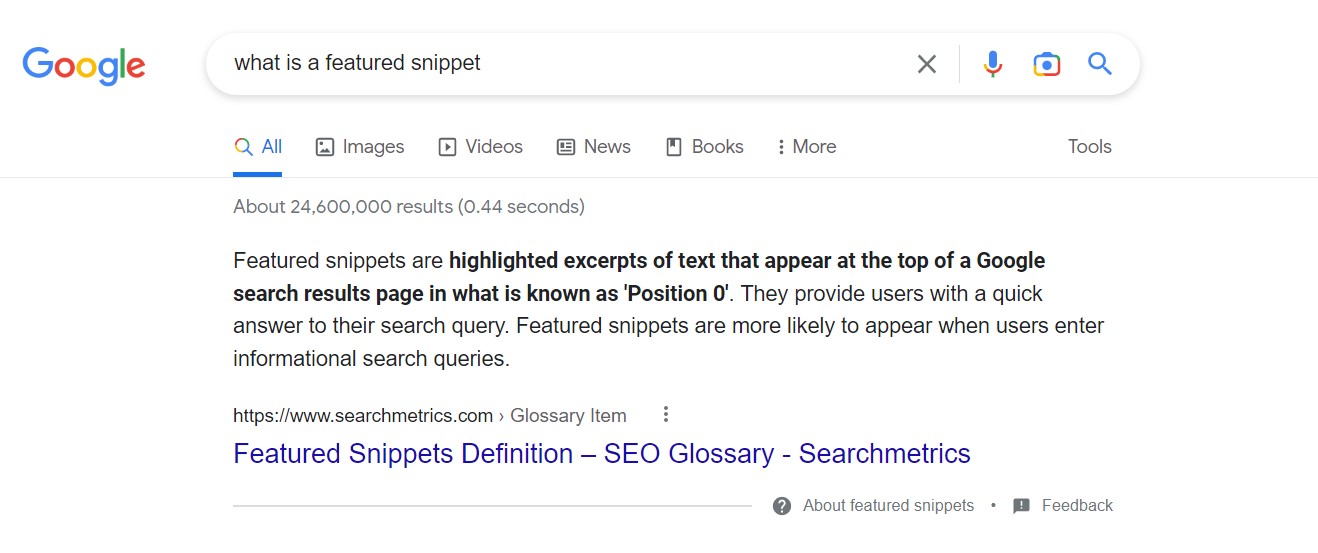With roughly 9 billion Google searches happening on a daily basis around the world, it would be an understatement to say that competition in the search engine optimization (SEO) world is fierce. Everyone is vying to rank in that number one position for their respective search queries. Strategists are constantly adjusting and refining the on-page elements, meta tags, links, and core web vitals, in an effort to appeal to the Google algorithm.
Search engine optimization (SEO), like other aspects of your digital marketing strategy, is constantly evolving. As Google continuously updates its algorithm—which controls the way it processes and ranks keywords—we as marketers need to be continuously aware of these changes and proactively make adjustments as needed. As we progress in to the New Year with a core Google algorithm update behind us, we’re pointing out four trending areas of SEO that will help you prepare your SEO strategy for 2023.
1. All Eyes on Featured Snippets
By now, you’ve noticed that the results for many of your Google searches look a lot like the below image: a featured snippet.
The idea of the featured snippet is to provide searchers with an organic result that directly answers their search, without requiring them to click into a website. This snippet can come in the form of FAQs, how-to’s, bulleted lists, or a simple sentence (similar to the above example). Google features the “snippet” of information at the top of the SERP when their crawl indicates that the page offers valuable, useful, relevant information which directly answers the searched query. As a result of this, featured snippets have been able to drive incredible amounts of organic traffic, making them extremely beneficial for SEO. Consumers want direct, quick answers, and that is exactly what featured snippets are able to provide.
Based on what we’ve gathered from Google’s recent helpful content update in August 2022, and the “people-first” approach they’re favoring, we can expect to see a lot more of these featured snippets in 2023. To optimize for this trend in the upcoming year, we recommend thinking carefully about the searcher and their intent, and focusing your content around question-based keywords. Ask yourself how your audience might be searching, what questions they might have about your service or product, and how you can provide them the most valuable information possible.
The best way to win a featured snippet is to provide content that answers what users are searching for immediately. Google’s autocomplete feature when searching, as well as the “People also ask” section within the search results, are both great tools when trying to determine the target keywords and questions users are searching for. When structuring your content for featured snippets, be sure to use subheadlines, clear and concise information, and bulleted or numbered lists. These elements can make it easier for search engines (and users!) to digest your content. Check out more best practices here.
2. Speak Up! Voice Search Optimization
As virtual assistant technologies, such as Amazon Alexa and Google Assistant, become more and more prevalent, the number of voice searches do as well. With over 40% of internet users currently utilizing voice search in the U.S., this number is only expected to increase through 2023 and beyond. Thus, ensuring your content is optimized for voice search is essential for your SEO strategy.
How do you optimize for voice search? Good question – it’s all about the specific, long-tail keywords. Similar to the featured snippet strategy, it’s crucial to figure out exactly what we think our target users will be asking. Voice search optimization is exposing a whole new SEO trend. Marketers are opting to target full questions or phrases rather than a few selected keywords. Rightfully so, as users typically speak in full sentences when voice searching, such as asking “is biology the right major for me?” These searches are also typically made through their mobile devices. Therefore, don’t be afraid to put some time into ensuring your website is mobile-friendly when optimizing for voice search!
3. Video Consumption: To Infinity and Beyond
It’s no secret that video content consumption is growing at a rapid rate. HubSpot research reports that 66% of consumers have watched video content (i.e., product demos, reviews, FAQs, unboxings, etc.) to learn about a brand or product in 2022. As we stated previously, users want fast, direct answers from their searches, and video content provides just that. Google has been rolling out features to make it easier for users to find information faster through videos. Additionally, a captivating video can prolong the time users spend on your site, which can result in Google awarding you higher organic rankings. That being said, it is critical to account and optimize for this SEO trend in 2023.
We recommend incorporating video into more of your pages when possible. Embedding overview videos into blog articles, how-to videos into pillar pages, explanation videos within solutions pages: integrate video content as much as you can (but don’t overdo it). SEO best practices recommend ensuring the video is relevant to the content of the page and incorporating one video per page. If third party or self-hosting, embed the content with HTML5 and JavaScript or Flash, but not an iframe. The addition of video content can be instrumental in helping you boost engagement, rankings, and traffic. Just be sure to use detailed, keyword-rich markups for the clip markups and schema markups to help search engines understand and categorize the information in the video.
4. Content is Still King: Write for Your Audience
Google redefined its ranking algorithm in 2022, however content remains king. Businesses and marketers should prioritize the creation of valuable, informational, long-form articles that appeal to their users’ search queries. With blogging and other forms of SEO-optimized site content, it is crucial to anticipate what your audience is looking for, to ensure you are providing them with helpful content. Focusing on this strategy is not only beneficial from a featured snippet perspective, but because it allows websites to rank for long-tail queries that users are searching for. Google loves informational content that provides value to users! This supports why Google has also been favoring review-type articles in recent months. Ultimately, Google aims to provide users with high-quality purchasing advice. As the number of review articles ranking organically on page 1 continues to increase, the influence these have over buyer decisions increases in tandem. GlobeNewswire research reported “95% of consumers read online reviews before they shop and 58% say they would pay more for the products of a brand with good reviews.” By having review content available for users, companies are able to get their information in front of more consumers and control their narrative.
2022 Algorithm Updates Behind Us
Before we officially say hello to 2023 trends, let’s take a minute to look back on the 2022 Google algorithm updates behind us.
- February 22, 2022: Google released the Page Experience Update for desktop. With this, page experience became a part of desktop ranking systems. Core Web Vital metrics such as Largest Contentful Paint (LCP), First Input Delay (FID), and Cumulative Layout Shift (CLS) were largely at play here.
- March 23, 2022: Google released the (first) March 2022 Product Reviews Update. Through user feedback, Google found that searchers benefit from seeing detailed reviews of products in the SERP. This update was released to build on Google’s ability to identify quality products reviews and put them on the forefront of search results.
- May 25, 2022: Google released the May 2022 core update. Core updates are significant adjustments made to the current search algorithms and systems in an effort to improve ranking methods.
- July 27, 2022: Google released the July 2022 Product Reviews Update for English-language product reviews. Again, with searchers favoring legitimate product reviews, this update was released in an effort to reward quality product reviews. This specific update was solely involving English searches globally.
- August 25, 2022: Google released the August 2022 Helpful Content Update. The helpful content update rewards pages where users seem to have a satisfying experience and appear to find the content helpful, and penalizes pages that do not seem to provide value to users.
- September 12, 2022: Google released the September 2022 core update. Core updates are significant adjustments made to the current search algorithms and systems in an effort to improve ranking methods.
- September 20, 2022: Google released the September 2022 Product Reviews Update. This update was also specific to product reviews written in English.
- October 19, 2022: Google released the October 2022 Spam Update. From time to time, Google makes improvements to how their automated systems are able to detect search spam. These are referred to as spam updates.
- December 5, 2022: Google released the December 2022 Helpful Content Update. This update builds upon the initial one in August, rewarding pages that offer a quality user experience and valuable information for users. The update also penalizes pages that appear to leave users dissatisfied.
- December 14, 2022: Google released the December 2022 Link Spam Update. With this update, they are utilizing SpamBrain, an AI-based spam-prevention software, to neutralize the effects unnatural links may have on search results.
Bring on 2023 SEO Trends
While the possibilities are endless for where the SEO trends of 2023 will take us, these are a few definite opportunities that we can count on as we progress into the age of the consumer.
If you have questions about how to navigate these 2023 SEO trends or if you are interested in other ways to enhance your SEO strategy, please contact us by email at sales@synapsesem.com or by phone at 781-591-0752.




